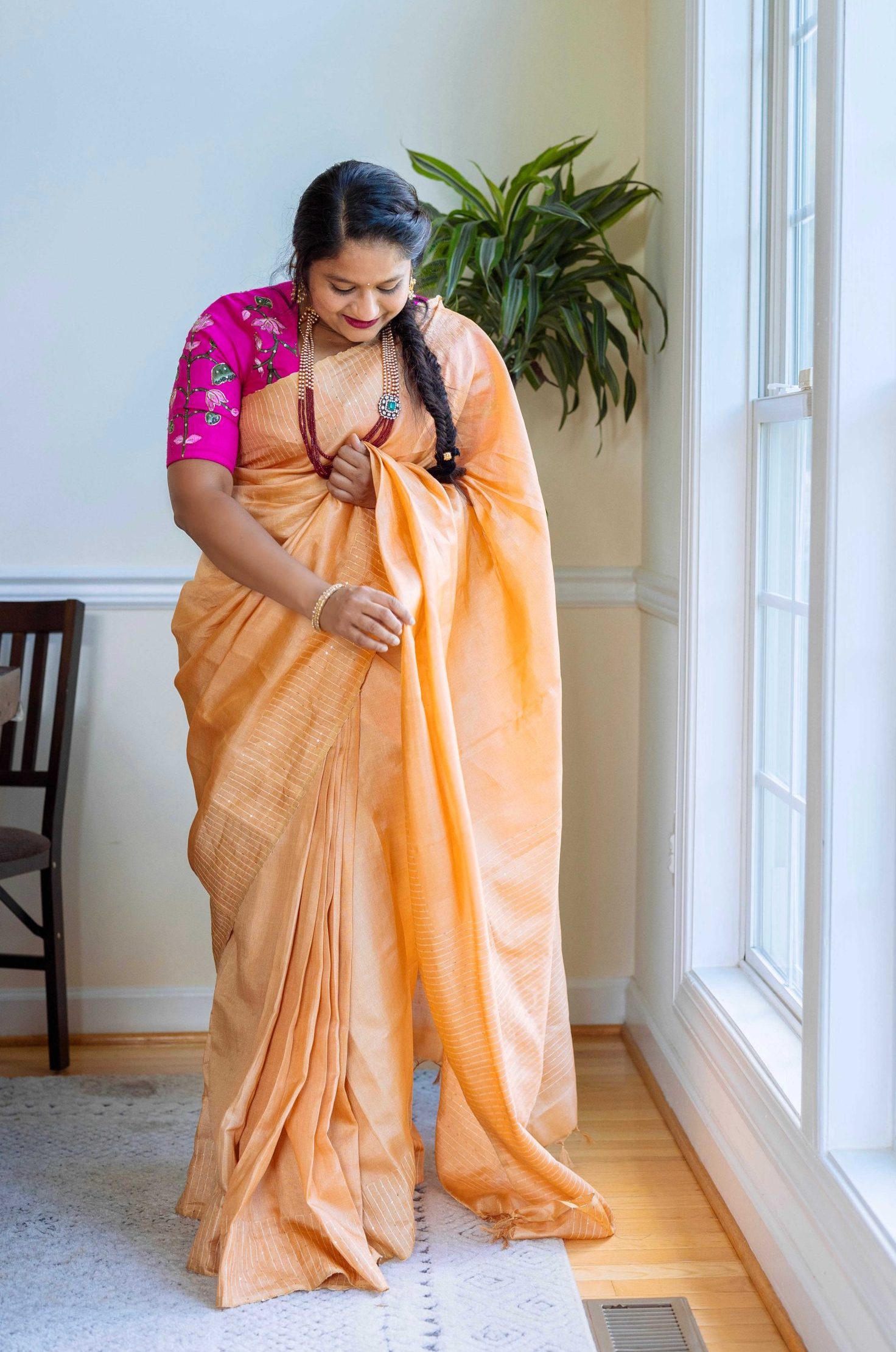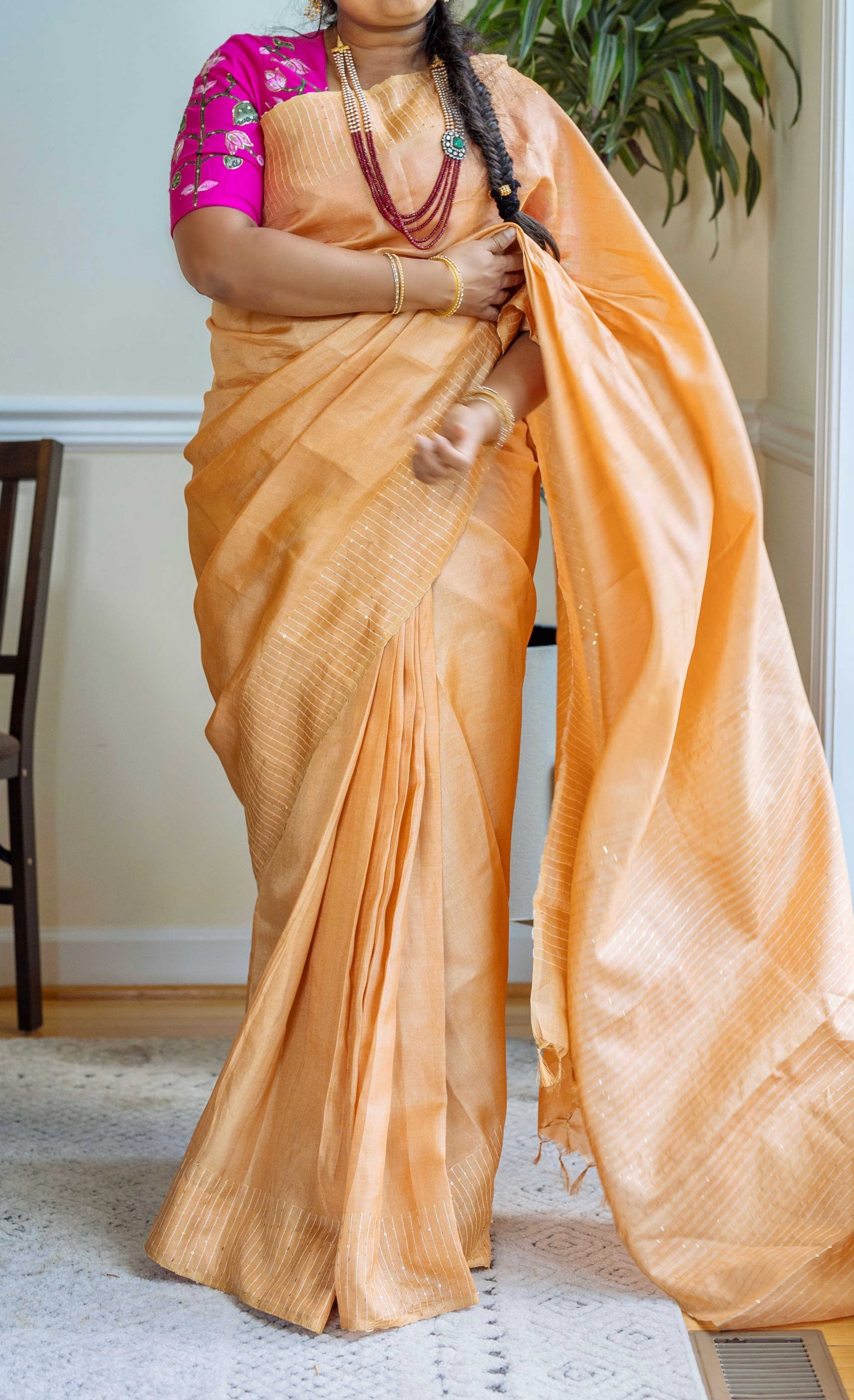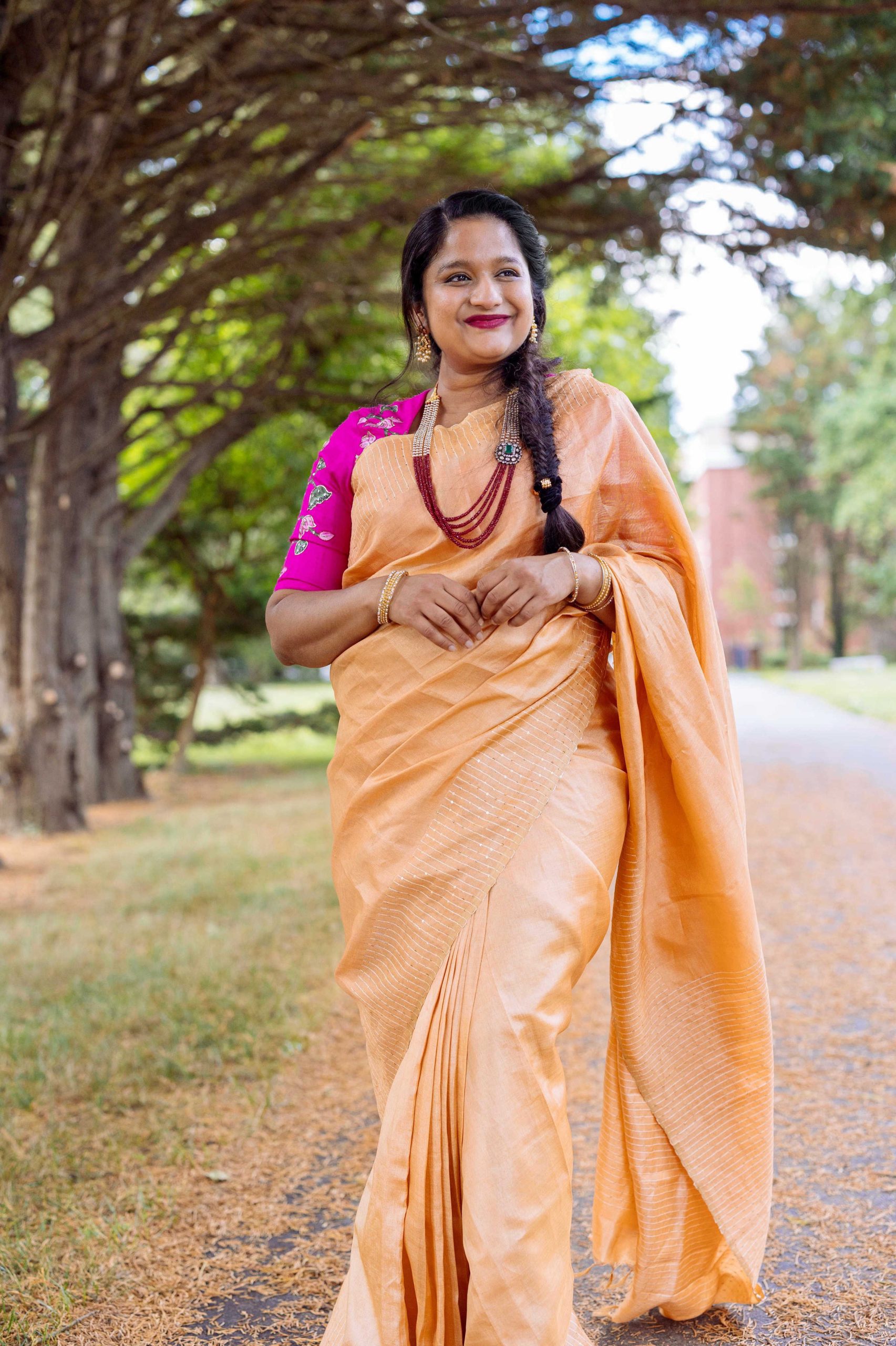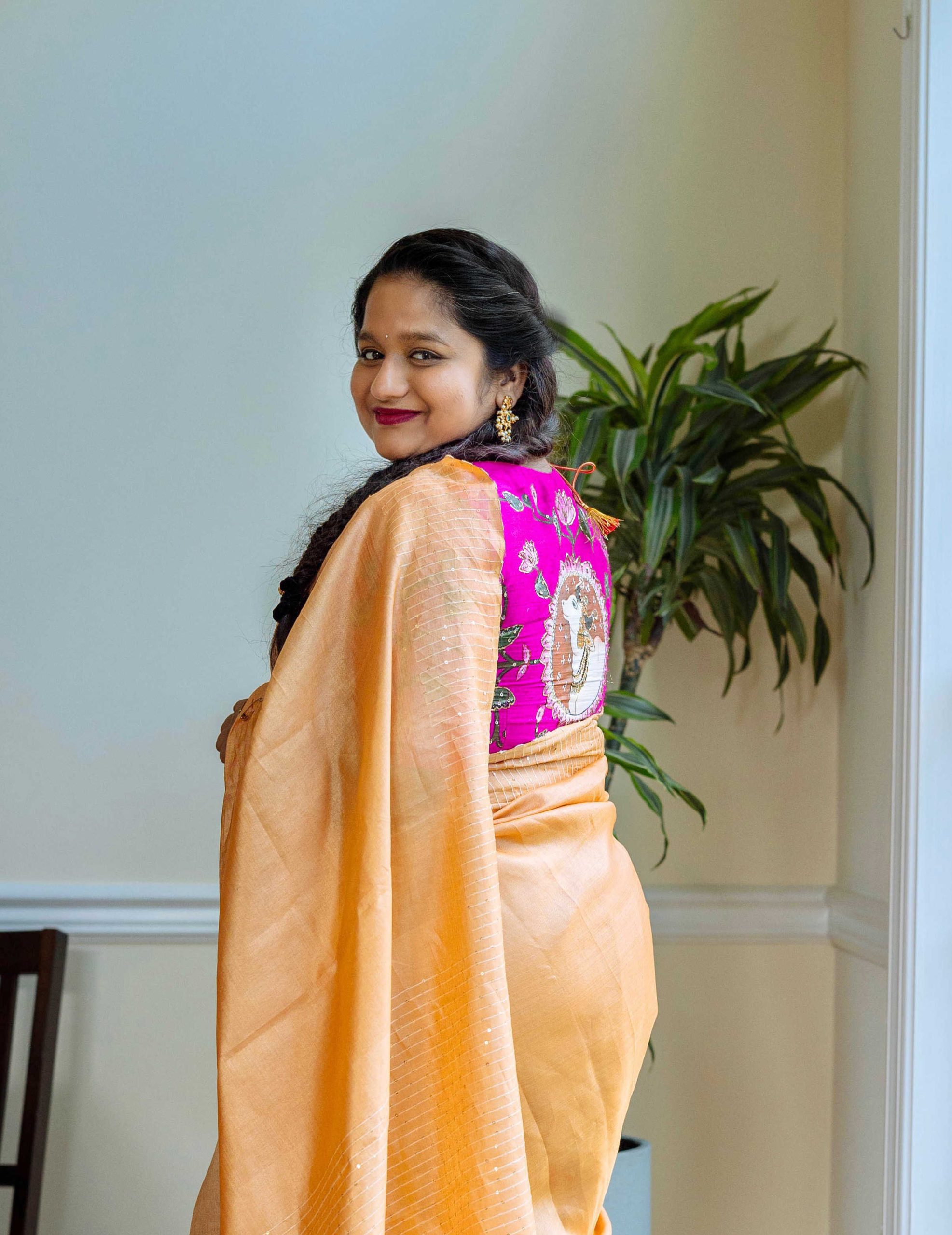Welcome to Episode 3 of Handlooms of India; In this blog post, I will delve into the enchanting world of the Kosa silk saree, exploring its origins, unique features, and how to check the authenticity and care for the saree. This series is my humble effort to learn, embrace and share about the Handlooms weaves of India.
You might also like these related posts:
- Handlooms of India- Bobilli Handloom Cotton Saree
- Handlooms of India-Tissue Banarasi Katan Silk Saree
- Indo-Western Outfit with Telia Rumal Blouse
- 2022 Navratri Outfits
Handlooms of India – Kosa Silk Saree with Pichwai Blouse
What is a Kosa Silk?
Kosa silk is a specific regional variant of Tussar silk specifically produced in the state of Chhattisgarh, India. It is extracted from cocoons grown on trees like Arjun, Saja, and Sal. The cocoons are weaved by a rare silk moth called Antheraea mylitta, commonly known as the tasar silk moth. Kosa silk is known for its fine texture, lightweight and glossy gold appearance.
Where is Kosa Silk Saree Originated From?
Kosa silk sarees originate from the state of Chhattisgarh. Devangan community from Champa, Bilaspur, Korba, and Raigarh are committed to producing kosa silk. Korba and Champa are known for producing high-quality Kosa silk.
The region’s favorable climatic conditions and the presence of the above-mentioned trees make it ideal for cultivating the silk-producing tasar silk moth.
What Distinguishes Kosa Silk Sarees from Other Silk Sarees?
The Kosa silk cocoons are beige in color with a golden tinge to them. The unique golden hue, derived from the silk moth feeding on Arjun, Saja, and Sal tree leaves, sets it apart from other silk varieties.
Kosa silk sarees are lightweight and have a smooth and glossy appearance as you can see from the pictures how the saree is shining, similar to a tissue Kanjeevaram.
Kosa silk sarees are only produced in Chhattisgarh and hold deep cultural significance in the state. They are often worn during weddings, festivals, and other special occasions.
How are Kosa Silk Sarees Made?
- Silk Extraction– First, the silk filaments are extracted from the cocoons of the tasar silk moth. The silk filaments are then spun into threads. This can be done manually or using spinning wheels.
- Setting the loom and Weaving– The warp threads are arranged lengthwise on the loom, and the weft threads are intertwined with the warp threads to create the fabric. The weaver creates the design or pattern for the saree and sets up the loom accordingly. Traditional designs often include nature-inspired motifs, geometric patterns, or intricate embroidery. The sequins on the saree I am wearing are actually woven, while the saree is in the loom.
- Dying – Once the weaving is completed, the woven sarees are further dyed in Natural dyes to obtain the desired color.
- Additional Designing: Depending on the design, additional techniques such as jacquard weaving, Jamdani work, hand or machine painting, or embroidery may be incorporated to enhance the beauty and intricacy of the saree.
- Finishing: Once the weaving is done, the saree goes through the finishing touches, which include washing and ironing to give the saree its texture and shine.
How to identify the authenticity of the Kosa silk saree?
Source and Origin: Kosa silk sarees are primarily produced in Chhattisgarh, India. Therefore, ensure that the saree you are considering is sourced from reputable weavers or sellers known for their authentic Kosa silk products.
Silk Test: The most common yet best way to confirm the purity of kosa silk is by burning a couple of fabric threads. If the fabric is original, the burnt threads will leave a residue, unlike typical ash. It is black instead of grey in color and has an unpleasant odor.
Due to the rarity of the Kosa worm and the laborious cost of cultivating it, the raw silk yarn is often blended with cotton or polyester. If it leaves an ash-like residue, it means the silk is mixed.
How to Care for Kosa Silk Saree?
- Always wash the Kosa silk saree with a mild detergent and air dry it in the shade.
- Wrap it in a muslin cloth or store it in cotton saree bags or pillowcases to protect them from dust, light, and moisture. Cotton is a breathable fabric that allows air circulation and helps prevent the accumulation of moisture, which can lead to mold or mildew growth.
- Store in a cool, dry place. Avoid places prone to humidity, direct sunlight, or extreme temperature fluctuations. Excessive heat and moisture can damage silk fibers and cause discoloration.
- Additionally, you can place natural moth repellents like dried neem leaves, camphor, or cedar balls in the storage area.
- Occasionally Unfold and refold in a different direction to prevent creases from setting in.
- Once the saree is completely dry, you can iron it on a low heat setting.
How I Styled the Kosa Silk Saree
I paired this beautiful peach color kora silk saree with a contrast Fucshia pink blouse. This outfit is something I would wear to weddings or housewarming parties, festivals, etc. It’s not something that would dominate the bride or host and is not simple either. The contrast adds visual interest and excitement to the outfit and makes it stand out.
The Pichwai blouse is handmade, too; it’s incredibly beautiful and something I can pair with other sarees as well. Can you believe the sequins are not embroidered? They are weaved into the saree in the loom. That way, I don’t have to worry about them falling out someday. I completed the look with a beautiful precious Ruby and Pearl mala; the pendant is 925 silver with Mossanites. I have not seen such a beautiful half and half mala; it was love at first sight.
Shop The Post
Handloom Kosa Silk Saree and handmade Pichwai Blouse from Kalavali
Precious Ruby and Pearl Mala with 925 silver moissanite pendant from Sriethnica















0 Comments